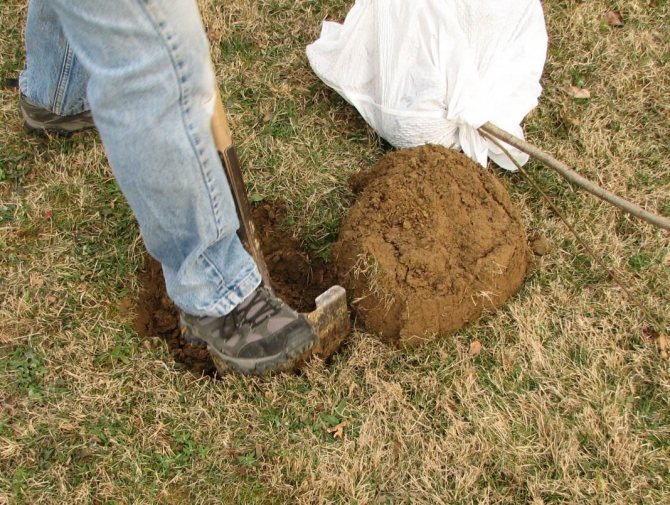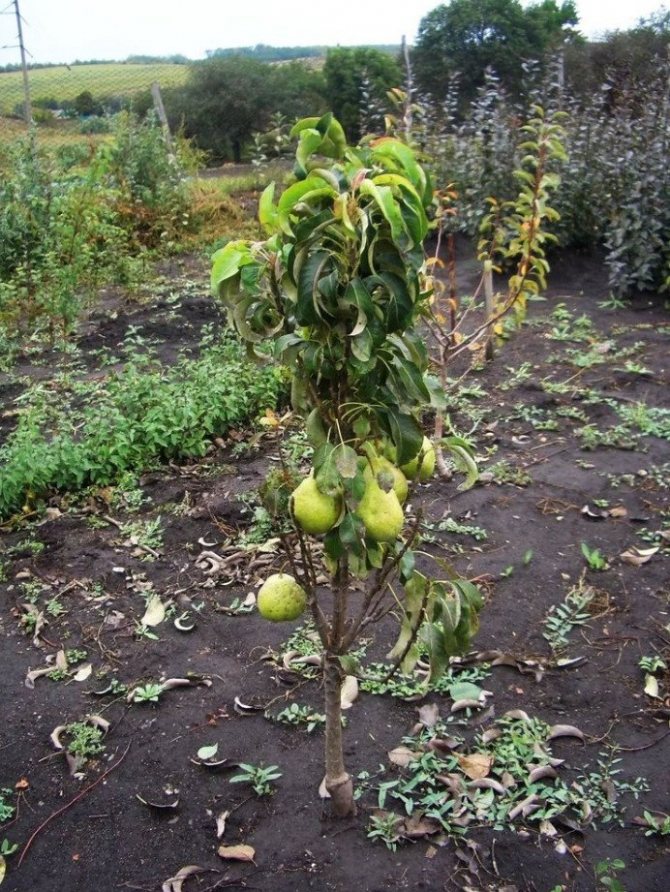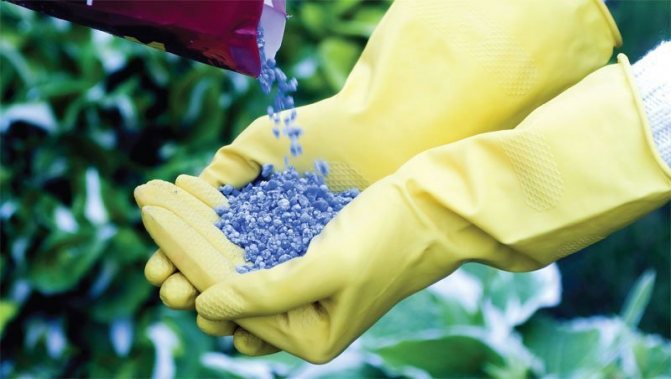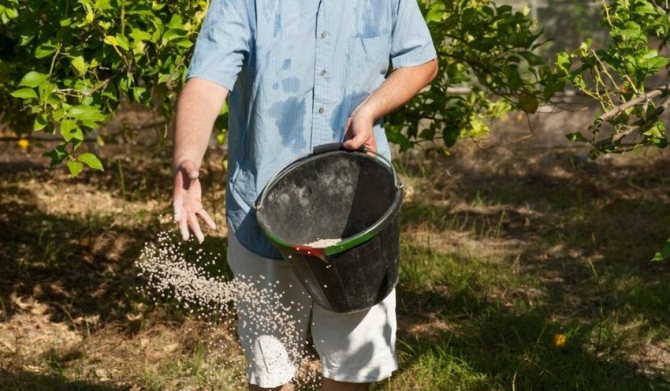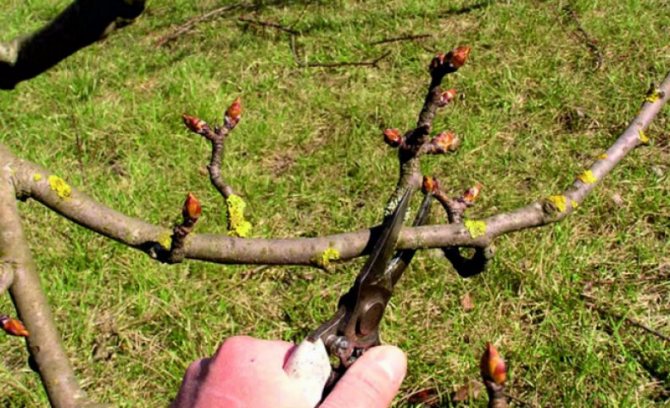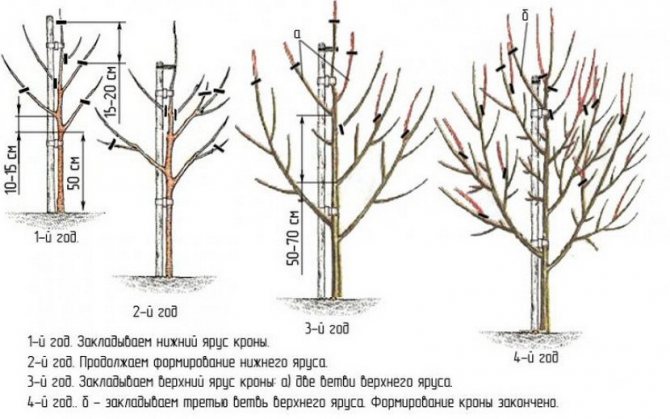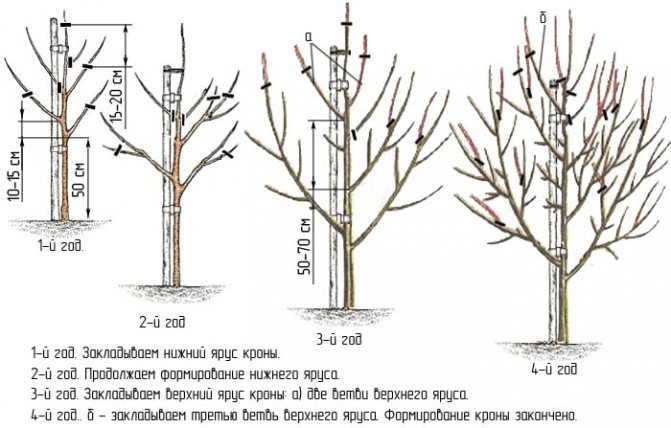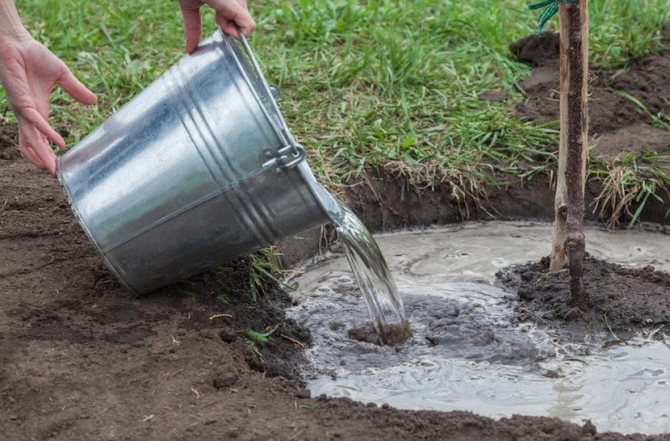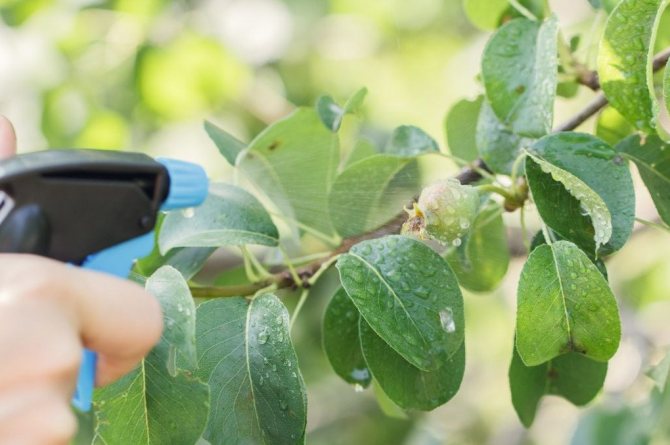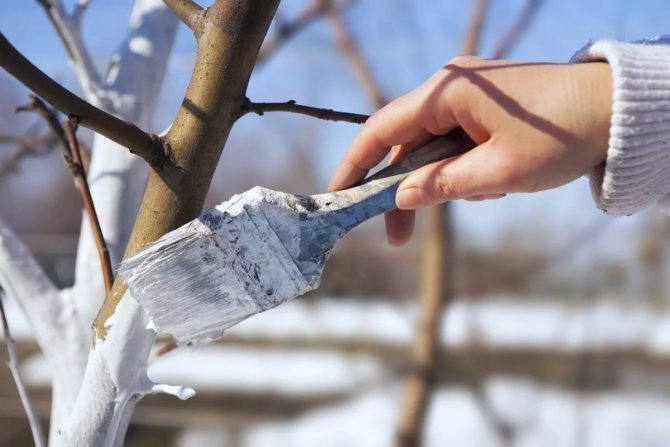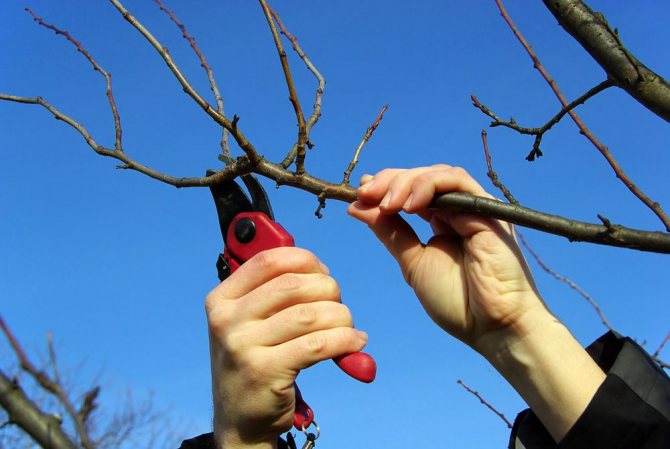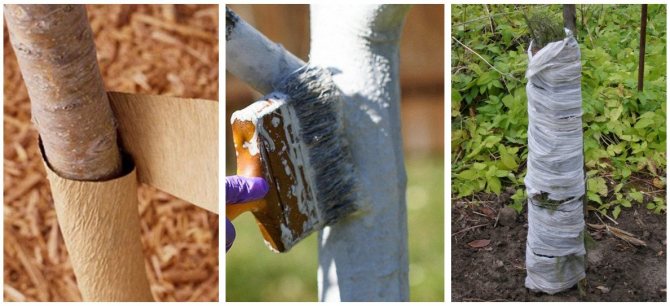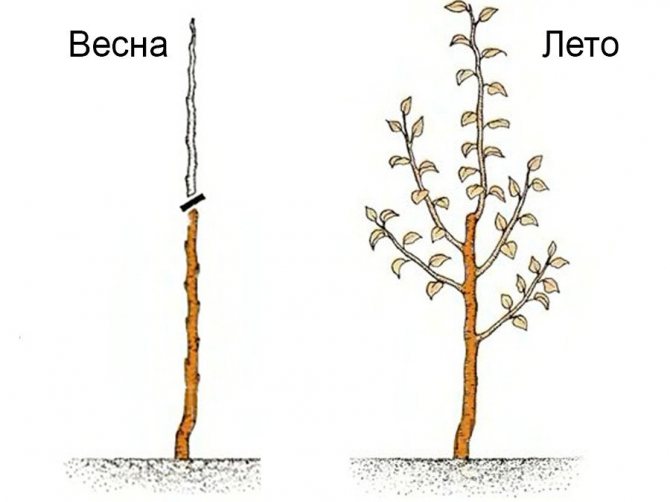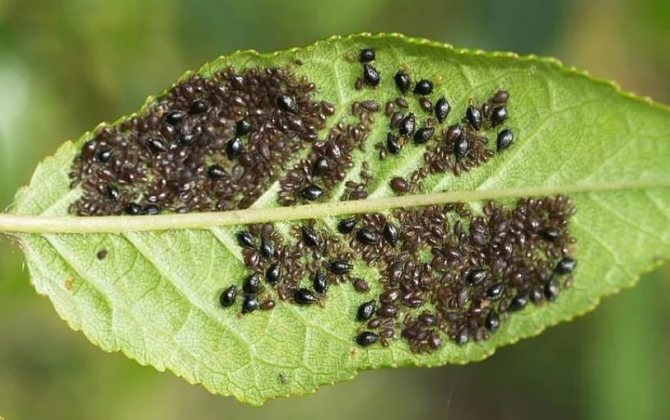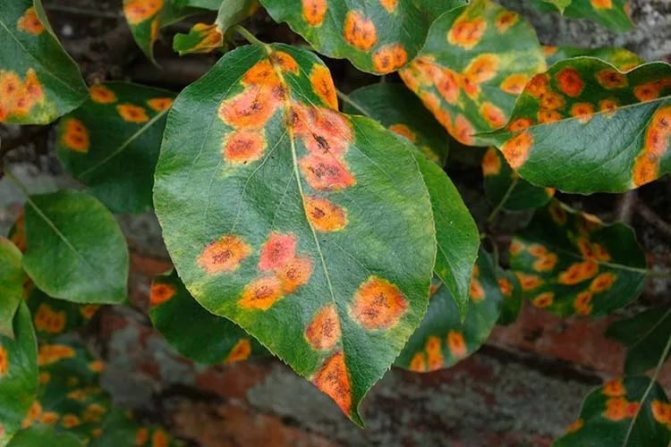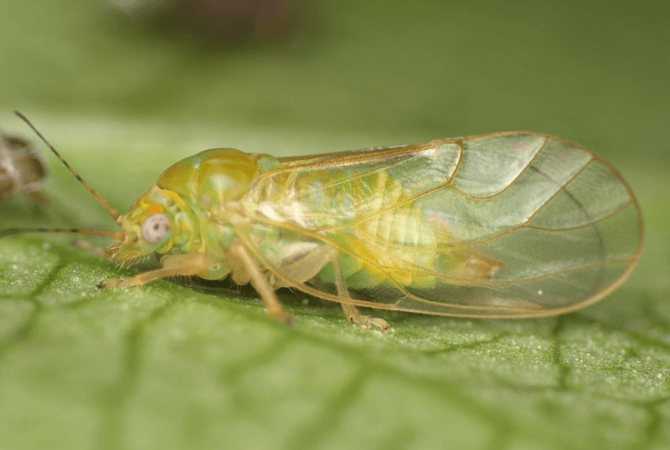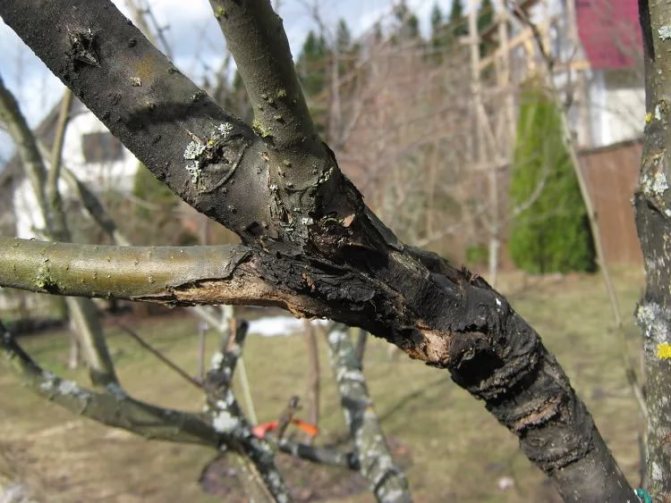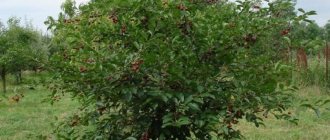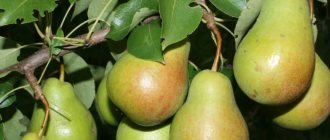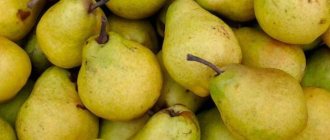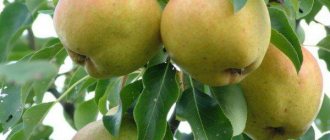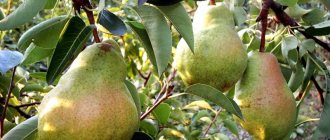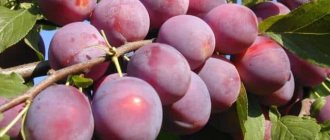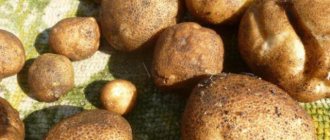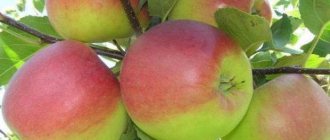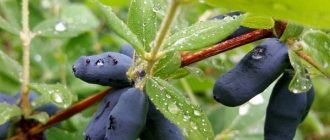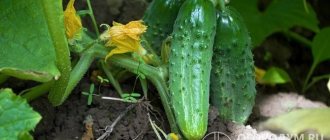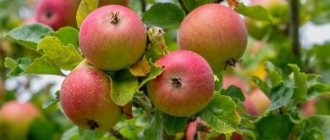A neighbor at the dacha treated me to a honey pear - she boasted of the first harvest of a recently planted tree. I have not tried anything like this before! The fruit was very juicy, sweet, tender and with a delicate aroma. At the same time, the pear was quite impressive in size. Now I know exactly what tree I will plant this spring in my country house.
In the article below I will talk about the specific features of the honey pear, its advantages and disadvantages, as well as the main stages of planting seedlings and caring for them.
Description of the cultivar
Honey belongs to the late autumn group of varieties. More than half a century ago, the seedling Bere Bosk, obtained by free pollination, was selected as a new hybrid at the Crimean experimental station. The originators of the cultivar, breeders V.A. Yakimov, R.D. Babina, A.F. Mileshko. Their labors made it possible to obtain an interesting specimen that brings incredibly tasty fruits.
Since the work was carried out in the Crimea, the second name of the cultivar is Crimean Honey.
Variety testing has been carried out in the North Caucasus region since 1992, but the southerner is found in the Central and Central zone of Russia. The pear has shown resistance to external factors, stable productivity, strong immunity.
The appearance of the tree
Medovaya trees belong to the medium-sized type. They are barely more than 2 m high, making harvesting easier. The shape of the crown is back pyramidal, there are not too many shoots and foliage. The main type of fruiting is ringed; ovaries also appear on fruit twigs. The flowers are frost resistant.
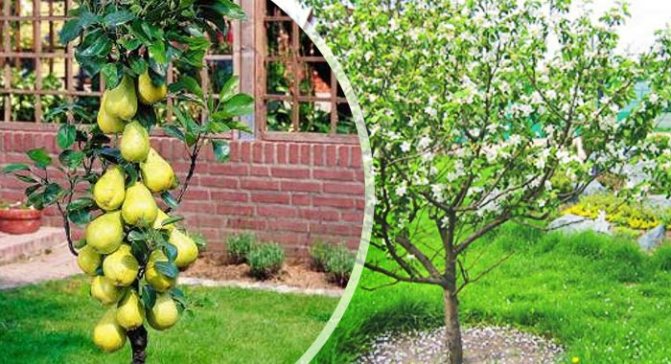
The tree is characterized by partial self-fertility. Cross-pollination with Tavricheskaya, Miracle, Bere Bosk or Bere Ardanpon will allow you to get a larger crop.
Description of fruits
Let's take a closer look at the description of the fruit of a honey pear:
- fruit size is large, weight 320-350 g. Especially large specimens gain weight up to 500 g;
- the shape is shortened, pear-shaped, asymmetrical. There are bumps along the entire surface, ribbing is observed in the saucer area;
- the skin is loose, dry to the touch, smooth, covered with a large number of small gray freckles. The skin color is greenish-yellow with a slight light brown tan, similar to a rusty area;
- the fruit is held in place by a curved, shortened stalk of medium thickness. There is no tendency to shedding;
- the taste characteristics of the fruits were evaluated by the expert commission of 4.6-5.0 points. The taste is sweet (after all, there are 10% sugar in pears), harmonious with a bright honey aftertaste, a pronounced aroma;
- a slice of creamy shade, buttery melting texture. Excretion of juice is abundant; ripening begins in the second decade of September, fruits are removed at the initial stage of consumer maturity;
- the shelf life of fruits is up to 100 days, transportability is good; they consume fresh harvest, make desserts, compotes, preserves, confiture.
Experienced gardeners are of the opinion that it is better to lay less sugar for making jam, since fruits are very sweet.
Honey subspecies
It is not surprising that on the basis of such a popular hybrid with a short stature, a columnar pear was bred. It is a tree up to 2 m tall with a dense straight stem and short branches. The columnar type is characterized by rapid development and fruiting from 2 years after planting.Such an intensive development period is associated with the short life of the tree itself - the duration does not exceed 12-15 years.
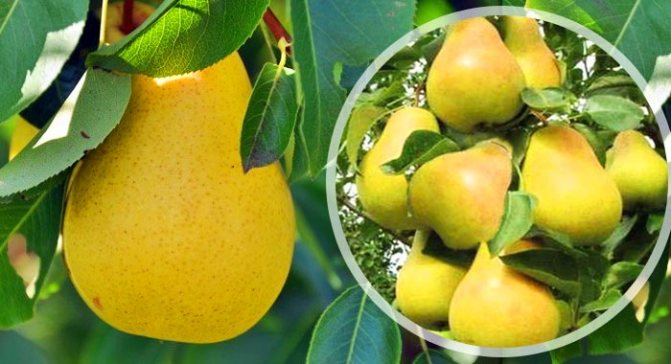

Taste qualities of pear fruits are similar to those described above, but the harvest ripens one-dimensional and its average weight is 400 g. Among the columnar subspecies there are trees with different ripening periods. The columnar variety of Medovaya has a great advantage - very compact dimensions. It can be planted in steps of 60-100 cm.
Advantages and disadvantages of the variety
To the disadvantages of the Honey pear, gardeners attribute a non-one-dimensional crop with a large number of ovaries. This problem is easily solved by rationing - removing unnecessary greenfinches. The frost resistance of the cultivar is low for Central Russia, therefore, in the Moscow region, the thermophilic southerner is carefully prepared for wintering.
Another significant drawback is the weakening of the health of the tree after a bountiful harvest. To avoid a heavy load, the amount of fruit is normalized at the ovary stage.
Description of the pear variety notes a lot of advantages:
- early maturity. The first crop is harvested 3 years after planting;
- lack of dependence of productivity on unfavorable environmental factors;
- high productivity. Mature trees of the Crimean Medovaya bring up to 100 kg of fruit, columnar trees will delight gardeners with 15 kg of selected fruits;
- compact dimensions of the tree make it a welcome guest in any garden, facilitate crown care and harvesting;
- the pride of the honey variety pear is selected fruits with excellent taste and market characteristics, the possibility of long-term storage and transportation;
- unpretentiousness to cultivation conditions, resistance to major diseases.
Harvesting
The yield of Honey is much higher than similar varieties - up to 110 kilograms of juicy and appetizing fruits can be harvested from one young tree. Fruit ripeness occurs in the second half of September. Pears do not crumble, they must be picked by hand, trying to preserve the stalk.
It is undesirable to harvest fruits that have not reached technical maturity. Such a pear does not ripen during storage, hardens and does not acquire the sweetness and aroma characteristic of this variety. The ripeness of the fruit is determined by taste and visual control. The peduncle is easily separated from the ripe fruit. The flesh should be creamy, tender but not crumbly. The color must correspond to the variety.
As for the columnar varieties, their ripening occurs at different times - from the beginning of August to the first decade of October.
Pears are best kept in the refrigerator at a temperature of +1 ° C - until January. Before storing, do not wipe the fruits under any circumstances, do not try to erase the wax coating from them - it protects the pear from damage. Can be stored in a cool dry cellar at + 4 ° C, wrapped in paper and laid out in a single layer on shelves or in boxes. If the fruits are intact, then they can well lie for 2 months.
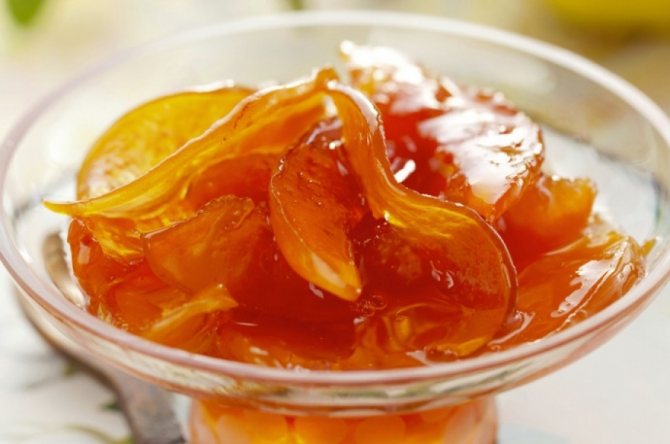

Fragrant seasonal preparations are obtained from Honey Pear
Of course, honey pear is best consumed fresh. But if the harvest was large, then you can prepare canned juices, compotes and jams (just do not overdo it with sugar). This variety is not suitable for freezing.
High resistance to the main diseases affecting the pear, early maturity and large yields - these are far from all the advantages of the Medovaya variety. Let's add easy care and juicy, sweet fruits. It is these qualities that the pear conquers new fans among gardeners.
Good day! My name is Irina. I live in a wonderful place - Crimea. Educator by education. I love nature and animals very much. I have been fond of floriculture for a long time, but I have just begun to master garden wisdom. My motto is live, learn. Rate the article:
- 5
- 4
- 3
- 2
- 1
(6 votes, average: 5 out of 5)
Share with your friends!
Landing technology
To get a pear tree, you need to visit a fruit tree nursery. Exclude the purchase of seedlings at fairs or markets, purchasing goods in such a place does not guarantee quality and compliance with varietal characteristics.
When buying a pear, pay attention to a thorough external examination. If the branches bend easily, have live buds, healthy-looking bark, feel free to make a purchase.
Checking the bark's vitality is very simple - gently poke the surface at the bottom of the trunk. If green tissue is visible under the skin, you have a viable tree in front of you.
Although it is recommended to buy closed-rooted seedlings, you can purchase an open-rooted plant just before planting. Examine the pear roots carefully. The length over 20 cm, the presence of lateral branches, elasticity, moderate moisture and the absence of damage suggests that the seedling will easily be taken in a new place. The planting of such a tree is carried out immediately.
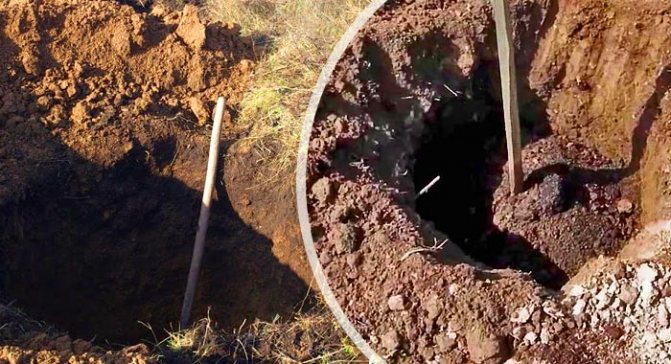

Planting work can be carried out in spring or early autumn. The first option is preferable for regions with a harsh climate, since during the summer the plant will get stronger and winters well. Until the beginning of October, it is customary to plant in the south of Russia. Warm autumn promotes the rooting of the seedling before winter.
Pear trees love warmth and good lighting. The combination of these two conditions allows you to get a good harvest. Protection from the cold wind is provided by placing a tree near a building or other obstacle. Pear Honey with its compact dimensions will easily fit into any garden. The soil for planting should be slightly acidic or neutral, loose, nutritious. If the site does not match, baking powder (sand) and organic matter are added to the planting pit. The occurrence of the aquifer is not closer than 2-2.5 m from the surface of the site.
If the soil is too acidic, apply lime when planting. Sour peat will help lower the pH of the soil.
How to plant a pear?
The process requires preliminary preparation, but even beginners can easily cope with this task. Follow these steps:
- a month before planting, dig a hole with a depth and diameter of 80 cm;
- mix fertile soil with the required amount of organic matter and sand, add a phosphorus-potassium complex. The number of components depends on the initial state of the soil at the site;
- make sure that there is a wind barrier and pollinators necessary for the culture nearby;
- pour drainage on the bottom of the hole, and form a slide from the prepared soil mixture on top. Install the support;
- place the roots of the pear in the hole and gradually fill it with earth so that no air pockets remain and the root collar does not end up under the soil;
- arrange an irrigation hole, water the tree abundantly. After complete absorption of moisture, tie the trunk to a support and lay out a mulch layer of sawdust or peat chips.
Do not forget that fresh manure is not used for planting. The fertilizer will burn the roots of the plant and lead to death.
Subtleties of pear tree care
A short care guide will help you keep your Honey Pear healthy. Water the seedlings weekly in the grooves with 1 bucket of warm water. A tree that has entered the time of fruiting is watered only before and after flowering, using 20 liters for each square meter of trunk space.
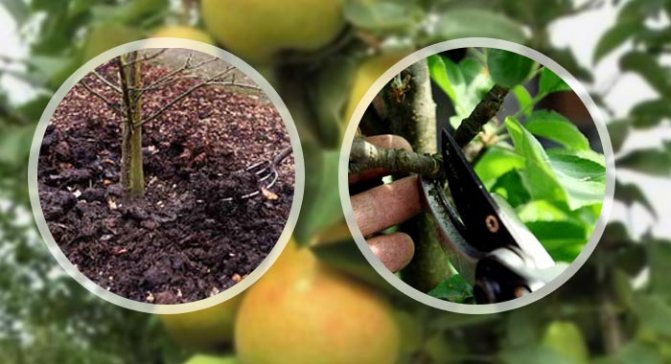

Top dressing is applied in 3 stages: nitrogen-containing fertilizers in early spring, potassium-phosphorus complexes before and after flowering, wood ash before wintering.
Pear Honey, according to the description, is hardy in the recommended region. Residents of the Middle Lane will have to prepare the tree for winter:
- after cleaning the near-trunk circle, carry out water-charging irrigation;
- fill the space of the trunk circle with humus to a height of 25 cm;
- wrap the trunk to a height of 80-90 cm with breathable material - agrofiber, cardboard, spunbond;
- wrap spruce branches around the "wrapper" for additional insulation and protection from mice.
Annual monitoring of the crown condition is carried out in early spring. Removal of thickening branches, diseased and dry shoots promotes ventilation of the crown, increases productivity.
A honey pear on the site will be a real decoration. The totality of the cultivar's advantages leaves no doubt among gardeners in purchasing a seedling of this particular variety.
Ripe pears are so sweet and flavorful. It is impossible to refuse them, because even the sight of these fruits stimulates the appetite. Imported pears can be bought at the store, but their quality is often questioned. At the same time, there is no more useful fruit than the one that is grown with your own hands in your garden. Therefore, every year the owners of the backyard plots purchase seedlings and carefully look after them in anticipation of the first harvest. So that he does not disappoint, you need to choose the right variety with the desired characteristics and, when growing a fruit tree, observe the basic rules of its cultivation. Today, the focus of our article will be the honey pear, because this particular variety is famous for the taste and external characteristics of the fruit, thanks to which it finds many admirers among gardeners.
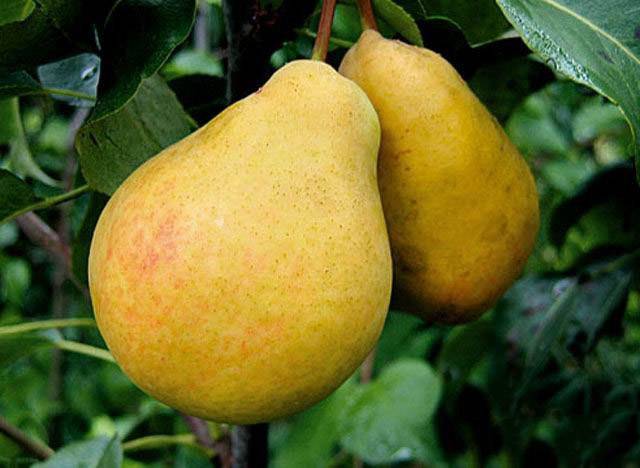

Detailed description of the variety
The pear of the "Medovaya" variety was bred by Russian scientists at the Crimean breeding station back in 1962 by pollination of the French variety "Bore Bosk". The authors of the novelty were three scientists at once, who, after many tests, presented their brainchild to the public only 30 years after its creation. It should be noted that the honey pear is still the object of attention of breeders who regularly research this variety.
Based on the results of long-term tests, breeders entered the variety into the state register of Russia and zoned it for the North Caucasus region. The pear received the official name "Crimean Honey".
Characteristics of the fruit tree
Column-shaped "Honey" pear with its height rarely exceeds 2 m. Its crown is ordinary, not very dense, throughout the growing season retains the shape of a pyramid. Such a medium-sized fruit tree requires periodic formation, with the removal of diseased, dry branches.
The plant is resistant to low temperatures and other features of various climatic regions. The pear successfully withstands winter cold snaps down to -25 0 С. The only exceptions are young seedlings, which can suffer from frost without adequate shelter.
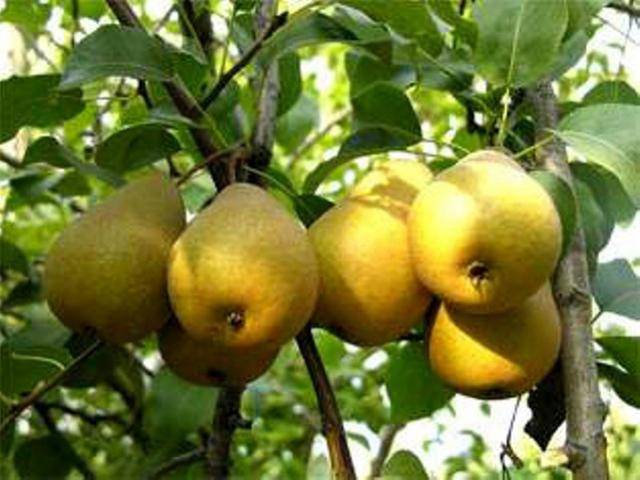

Fruiting of "Honey" pear is regular. Every year, starting from the age of 4-5 years, it gives off a large number of ripe, high quality fruits. Weather conditions in the region in spring can only slightly affect the yield of the fruit tree.
Blossoming of "Honey" pear is observed in May. It is always abundant and long lasting. Pear flowers are simple, collected in inflorescences of 2-5 pcs. Ripe fruits hold well on short stalks and require manual collection. The yield of an adult Medovaya tree is 20-30 kg. In some cases, this figure can reach 40 kg.
Fruit characteristics
It is not for nothing that the proposed variety of pears got its name, because in its taste there are indeed notes of honey. The most delicate fruit pulp, creamy in color, is poured with sweet, aromatic juice. When bitten, it literally melts in the mouth.
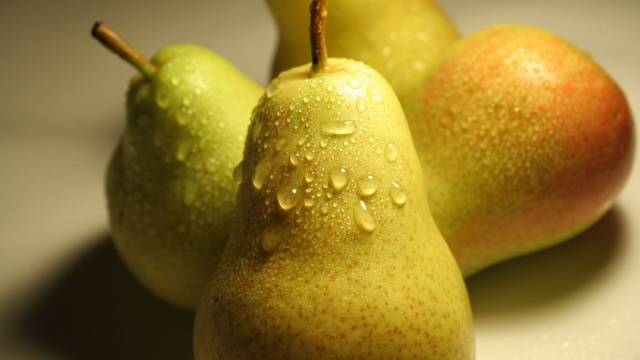

Honey pears are quite large. They weigh about 400 g, and some specimens of fruits reach a mass of 500 g. Their surface is dull, the skin is thin. Some roughness of the fruit can be detected by touch. The pear shape is classic, the base is thickened. Coloring of "Honey" fruits is yellow-green, in some cases brown or pink blush is observed.On visual inspection, you can see small gray or green subcutaneous dots on the surface of the pear.
Microelement composition of pears
The taste of "Honey" pears is largely determined by their microelement composition. So, the special sweetness of fruits is provided by a large amount of sugar, which exceeds 10%, while other pear varieties contain only 6-7% of this substance.
In addition to sugar, the fruit contains 6% vitamin C, a certain amount of organic acids and a huge variety of minerals. The fiber content of fruits is not high.
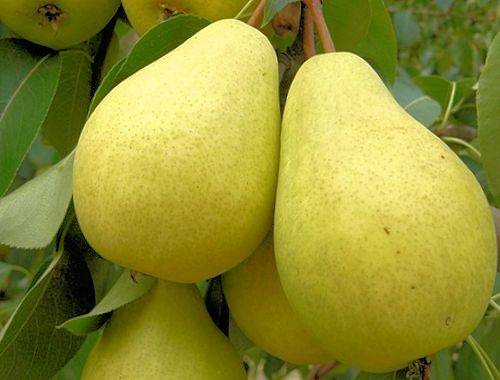

Purpose of fruit
"Honey" pears are so tasty that they are usually quickly eaten without waiting for processing. However, if necessary, you can make juice or jam from them. Sweet fruits are also suitable for preparing baby food.
An important advantage of the variety is the possibility of long-term storage of pears. So, for 3 months, fresh fruits can be successfully stored at a temperature of 0- + 5 0 C.
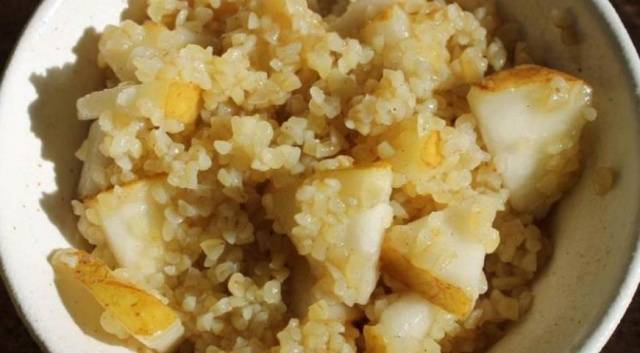

Subspecies of the proposed variety
Research on the honey variety pear has been going on for many, many years. And during this time, 5 subspecies of this variety were obtained. All of them are distinguished by their early maturity and some peculiarities in taste, shape, color of fruit:
- G-1 is the latest (winter) subspecies of all "Honey" pears. Its fruits ripen with the arrival of frost. They have a bright yellow color, weight up to 250 g, and some roughness of the surface.
- Pears of subspecies G-2 ripen in the middle of autumn. Their mass rarely exceeds 200 g. A brown blush can be seen on the surface of such fruits. There is a special aroma and sweetness in the taste of the fruit.
- Subspecies G-3 symbolizes the classic, bright yellow pear, weighing up to 400 g. Such fruits ripen with the arrival of the first autumn days.
- G-4 is an autumn variety bearing fruit of medium size (pear weight up to 300 g).
- G-5 is the earliest maturing subspecies. Its fruits ripen in summer. Their mass is small (only 250 g), but the taste is excellent, sweet, aromatic. On the surface of such pears, a brown tint is clearly visible.
Thus, under the name of one variety, 5 different subspecies are hidden at once, each of which has its own characteristics, which means that when purchasing a seedling, it will be useful to clarify which marking this or that fruit tree belongs to.
Disease resistance of the variety
The "Honey" variety demonstrates high resistance to only two common diseases: moniliosis and clasterosporiosis. Resistance to other diseases is not observed, therefore, it is recommended to carry out preventive treatment of plants when growing a variety:
- The scab covers the leaves of the fruit tree with dark spots that grow over time. Velvety olive spots appear on the fruits. The disease can be prevented by spraying the plants in the spring before the buds dissolve with Bordeaux liquid. The affected areas of the tree should be removed and burned.
- Rust is orange or red spots on the leaf surface. As a prophylaxis of the disease, you can use the drug "Skor". Also, antifungal drugs introduced into the soil along the near-trunk circle during digging of the soil demonstrate high efficiency.
- Fruit rot is represented by characteristic spots on the surface of the fruit. For the treatment of the disease, it is necessary to use the drug "Dnok".


In addition to diseases, various pests pose a threat to the "Honey" tree. The most common of these are aphids and mites. Information on insect control methods can be found in the video:
Advantages and disadvantages of the variety
Having thoroughly studied the description of the honey variety pear, photos and reviews about it, one can objectively talk about the advantages and disadvantages of culture. So, gardeners note the following positive points characteristic of the proposed variety:
- Fruits are distinguished by their special juiciness, sweetness and aroma.
- The fruits keep well for a long period of time.
- Sweet pears can be used to prepare baby food.
- Fruit trees are characterized by good winter hardiness.
- The yield of the variety is consistently high.
- Good presentation and excellent transportability.
- High immunity to some common diseases.
- Fruit shatter resistance.
- Decorativeness of the fruit tree.
- No need to form a crown regularly.
- Regular, annual fruiting.
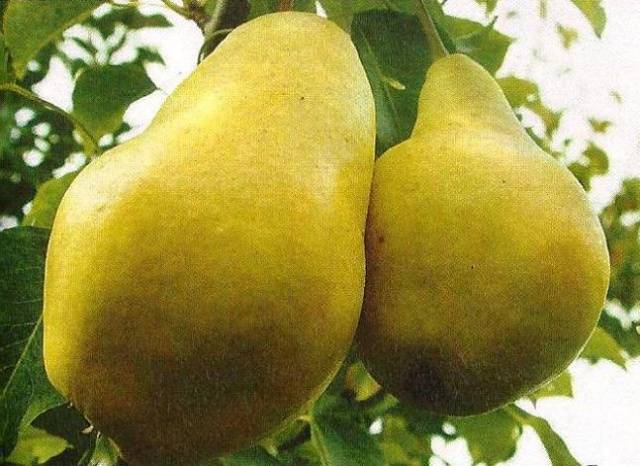

There were no serious shortcomings in the cultivation of the "Honey" variety, so it is worth highlighting only some of the features of these fruit trees:
- Ripening fruits are not uniform in weight. Large and small pears can ripen on one tree.
- For some diseases, it is necessary to carry out preventive treatment.
- The unusually high fruit yield reduces the frost resistance of the fruit tree.
The listed advantages and disadvantages must be taken into account when choosing a variety and growing a crop. So, after collecting a particularly rich harvest, you need to take care of treating the plant trunk with whitewashing, applying appropriate fertilizers to the soil and mulching it. All other intricacies of cultivating the "Honey" variety can be found further in the section.
Pests and diseases, methods of dealing with them
Although Medovaya is highly resistant to some diseases, for example, to moniliosis. But there are other diseases to be wary of when growing this pear.
One of the most dangerous pear diseases is black cancer, which, in the absence of timely measures, can lead to the death of the tree.
For young trees, brown leaf spot or phyllostictosis, which causes premature leaf fall, is dangerous.
Table: pear diseases and their treatment
| Name | Manifestation of the disease | Prevention and treatment |
| Black cancer | Brownish-brown spots appear on the bark of trunks and branches, sometimes with a cherry tint, which subsequently darken and are slightly depressed. Circles with black tubercles appear around the site of infection. |
|
| Phylostictosis or brown leaf spot | The appearance in June on the leaves of many small brown spots, on which then black spore pads grow. |
|
Any tree that is most resistant to diseases can be affected by harmful insects, for example, scale insects, aphids, hawthorn caterpillars.
Table: pests and control
| Name | Manifestation of the pest | Control measures |
| Shield | The appearance on the trunk, main branches and shoots of reddish-brown tubercles, from which dark juice is released under strong pressure. Drying of affected branches. |
|
| Aphid | The leaves curl into a tube, the petioles and stalks are deformed, with severe damage, young shoots begin to dry out. The affected parts of the plant are covered with a layer of insects. |
|
| Hawthorn | Caterpillars of the hawthorn butterfly eat leaves, for wintering they make nests of leaves, fastened with cobwebs. |
|
Photo gallery: learning to recognize diseases and pests of pear
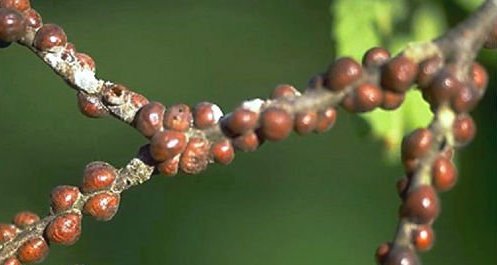

The scabbard sucks the juices from the shoots, causing them to dry out
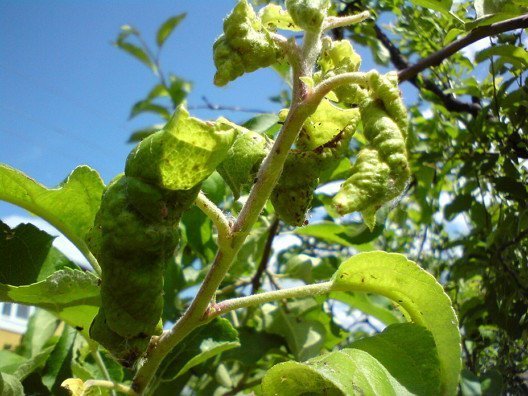

Aphids infect leaves and young shoots Hawthorn caterpillars actively damage leaves Phylostictosis is rarely found on mature trees, but dangerous for seedlings Black cancer is a dangerous disease that leads to the death of the tree
Growing features
The honey pear should be planted in the fall on the sunny side of the site. At a distance of 3 m from the seedling, it is recommended to place pollinating seedlings, varieties "Tavricheskaya" or "Wonderful". The soil on the site should be dominated by sandy loam, neutral or alkaline acidity.
After planting and in the future, throughout the entire cultivation period, a pear of the "Honey" variety should be watered abundantly once every 7 days. During flowering and fruiting, the tree is watered less often, but more abundantly, based on the calculation of 20 liters. water per 1 m 2 of the trunk circle. After watering, the soil in the trunk circle must be loosened and mulched with organic matter or straw.
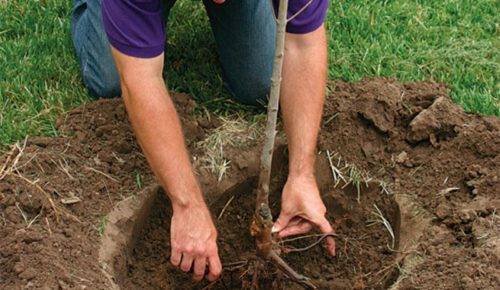

On fertile soil, seedlings of the "Honey" variety do not need to be fertilized for 2 years. In the future, it is recommended to apply fertilizers 4 times per season:
- during flowering, nitrogen should be used;
- after flowering, it is necessary to apply nitroammofosk;
- in the middle of autumn, add superphosphate;
- with the arrival of stable cold weather after harvesting, wood ash should be added to the soil.
Young seedlings in harsh climatic conditions must be prepared for frost as follows:
- Water the plants regularly and abundantly.
- Whitewash the trunk and wrap it in burlap.
- If possible, wrap the crown of a young pear with breathable material.
The listed rules will help to grow a healthy, abundantly fruiting pear and protect it from even the most severe frosts.
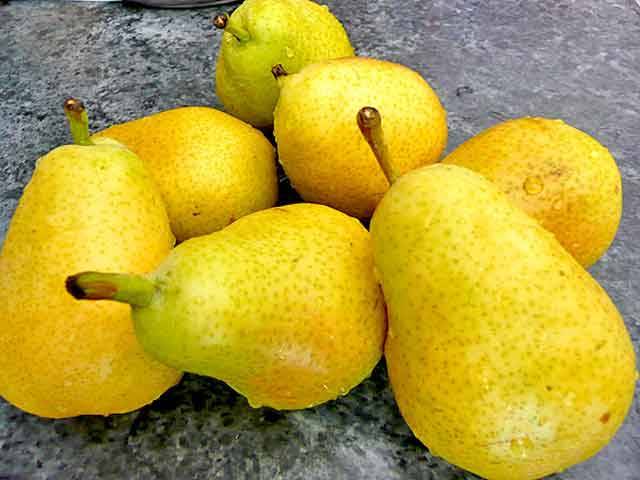

Can a honey pear be pollinated by a marble pear
An equally interesting variety of pear that justifies its demand is the Marble variety. Many gardeners are interested in the influence of this species on the yield of Honey in the issue of pollination.
So, the above varieties of pears can be grown simultaneously on the same garden plot, however, they are not suitable for transferring pollen to each other, since the periods of flowering and ripening in plants do not coincide.
Did you know? The legendary poet Homer, in his epic poem The Odyssey, called the pear a gift from the gods. According to mythological data, the fruit was presented as a sacrifice to more than one deity. For example, in Greece it was Aphrodite (goddess of beauty and love) and Hera (patroness of marriage and motherhood), and in Rome
—
Juno (goddess of the family and female productive force) and Venus (patroness of beauty and carnal love).
The main features of the plant
This pear variety has a number of advantages, in addition to its excellent sweet taste and good storage of the fruit. The main characteristics of the plant include:
- the plant has a late autumn ripening period;
- early-growing culture - 3-5 years after planting, you can already enjoy the first fruits;
- the variety is partly self-fertile; to obtain the maximum yield, the plant needs pollinators;
- this variety is grown in warm or temperate climates;
- Honey belongs to low crops - the tree reaches a height of up to 2 meters and has a crown of medium density and pyramidal shape;
- the fruits of this variety are quite large and on average reach 400-550 g, the pears are unequal, short-pear-shaped, have bumps;
- ripe fruits have a yellow-green color with a brown blush, their skin is thin and smooth, the subcutaneous points are small and have a gray color;
- the pulp of pears is fragrant, creamy, juicy with a slightly oily texture;
- pears have good transportability and are well stored;
- pears are consumed fresh and used for homemade preparations, since the fruits are very sweet for preservation, they need less sugar than for other varieties of pears, but they are not suitable for freezing;
- this pear variety has a subspecies - a columnar variety;
- the plant has a stable and high yield, but with too many ovaries, pears have very different sizes;
- ripe fruits do not have a tendency to crumbling;
- winter-hardy variety.
Reviews of summer residents
- Unfortunately, this variety of pears does not grow in our summer cottage, but every year we receive a treat from our neighbors. They have this variety for many years now bearing fruit abundantly, and every year, so they treat us. Pear variety Honey really has a very sweet, honey-like fruit with honey pulp that “melts in your mouth”.
- Such a pear has been growing in my dacha for ten years already. How much the harvest gives, somehow it did not measure, just every year they enjoy the taste of the fruits with their family. My children are already adults, but every year they take pears and eat like that for jam, and my wife and I also have time to eat plenty of food for the winter. We usually do not store fresh fruits, but in a small amount in the refrigerator they really lie for a long time.
- Honey is deservedly my favorite variety of pears. The son planted the tree eight years ago at the dacha. The plant is small and compact, but it always yields well. Pears are very tasty, soft, juicy and sweet, we use them instead of dessert in the season. They kept a little for the grandchildren in the cellar, they lie, in principle, well, but they ate it in less than two months.


